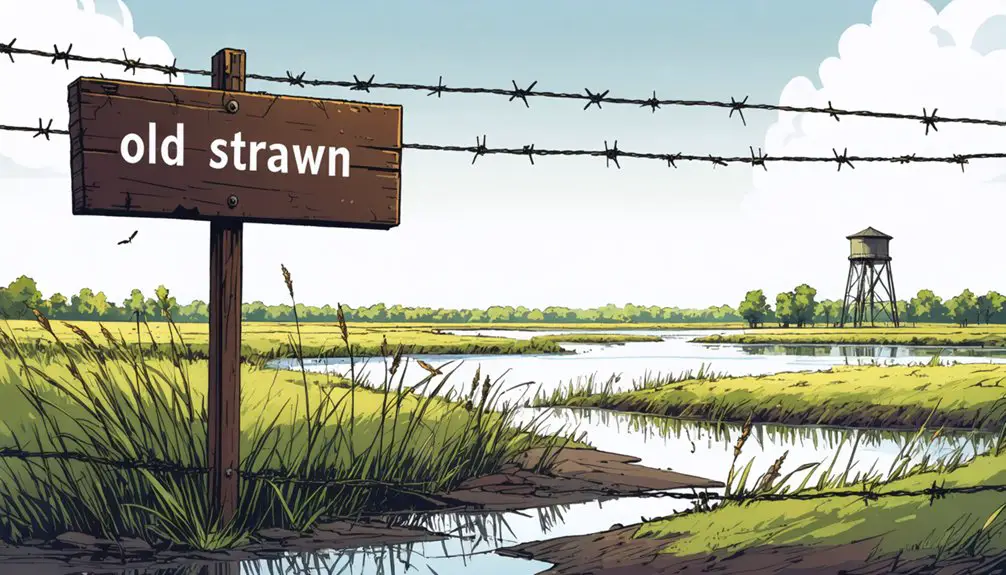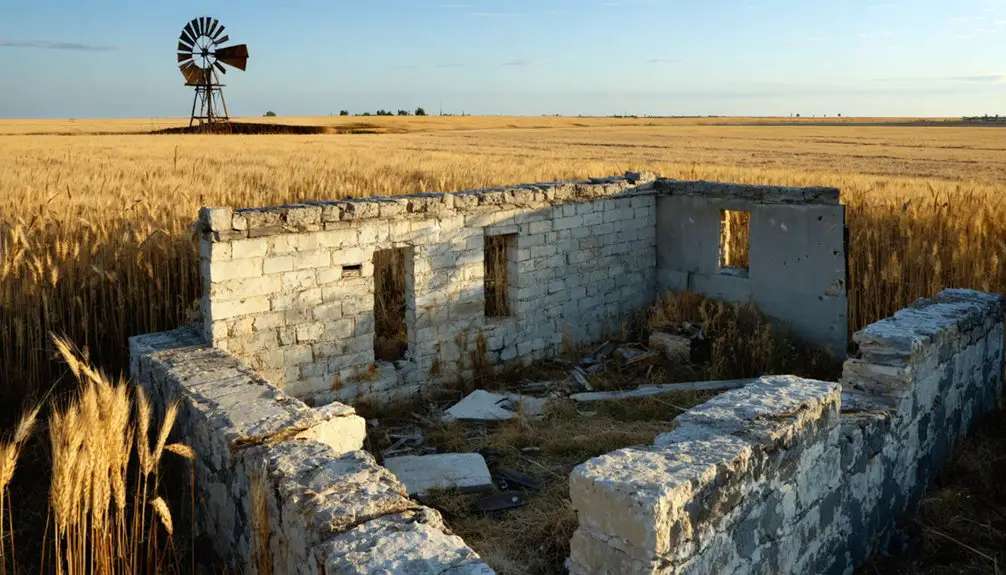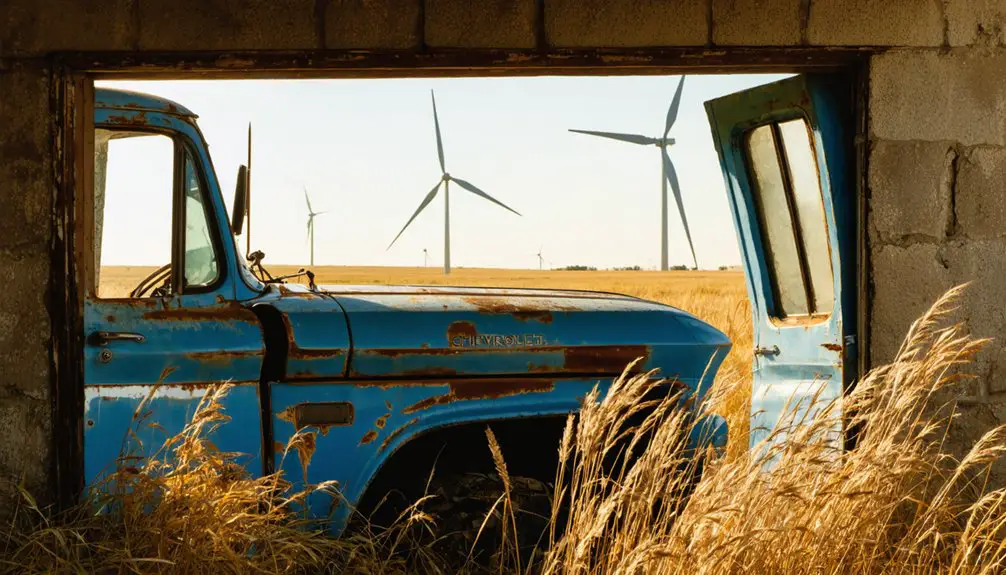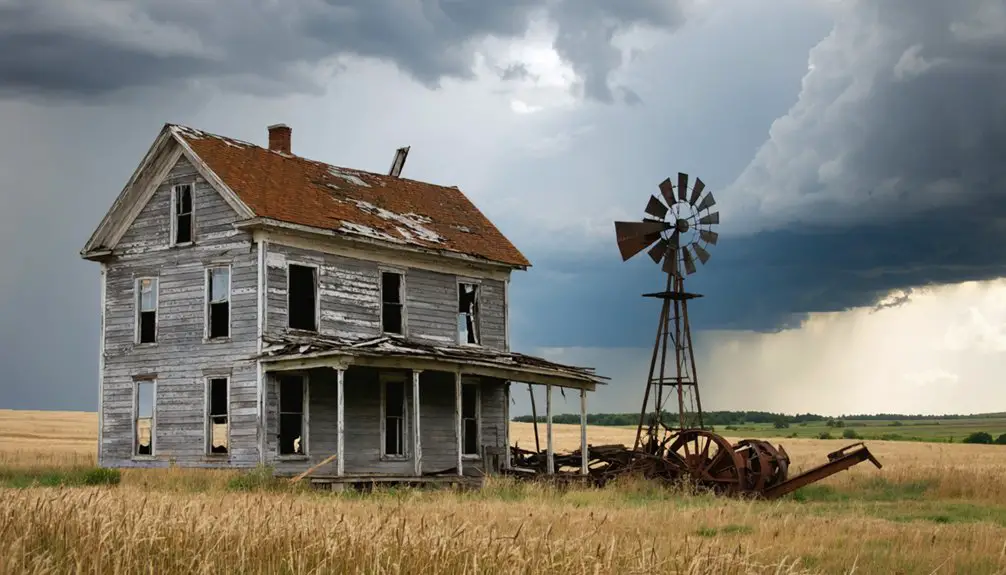You’ll find Strawn, Kansas‘s haunting story unique among ghost towns – it wasn’t gradually abandoned but deliberately relocated due to catastrophic flooding. Founded in 1855 near the Neosho River, the town flourished until the devastating flood of 1951 submerged it under 6-8 feet of water. Residents chose to move their entire community rather than disperse, establishing New Strawn nearby. Today, the original town lies beneath John Redmond Reservoir, its few remaining structures telling tales of a community’s resilience.
Key Takeaways
- Strawn, Kansas became a ghost town after the catastrophic 1951 flood submerged the community under 6-8 feet of water.
- The construction of John Redmond Dam prompted residents to relocate the entire town, establishing New Strawn in 1960.
- Only three original structures remain from old Strawn: a historic church, schoolmaster’s house, and coal weighing foundation.
- The original town site is now underwater, with the surrounding area largely returned to farmland with few visible historical remnants.
- Strawn experienced dramatic population changes from its 1855 founding until abandonment, peaking during mining operations with 3,000 residents.
The Birth and Early Years of Strawn
As Kansas approached statehood in the mid-1800s, the small settlement of Strawn began taking shape in Coffey County, marked by the construction of its first frame house in 1855.
The area was rich in natural resources, with native trees like oak, hickory, and hackberry dotting the landscape. You’ll find that the area’s founding families established themselves alongside other settlers in the Neosho Valley region, with nearby towns like LeRoy and Ottumwa emerging that same year.
It wasn’t until 1871 that surveyors officially mapped out Strawn’s town site, and by 1872, it had become an established town. The town was named after Enos Strawn, who provided crucial support to the MK&T railroad.
The community’s backbone consisted of retired residents and farmers who’d settled near their agricultural lands.
While early agriculture dominated the local economy, you won’t find records of major businesses or infrastructure projects beyond individual homesteads during these formative years.
Nature’s Wrath: The Flooding Years
While Strawn’s early settlers believed they’d chosen ground safely above flood stage, the town’s relationship with the Neosho River would prove far more turbulent than anticipated.
From 1904 to 1951, you’d find Strawn increasingly at nature’s mercy as deforestation and land drainage amplified flooding risks. The lack of flood management and ecological consequences of environmental changes became painfully clear as the Neosho repeatedly breached its banks. Total damages across Kansas reached an estimated $500 million in destruction.
Man’s reckless reshaping of the land left Strawn defenseless against the Neosho River’s growing fury.
The devastating flood of July 1951 delivered the final blow. As 8-16 inches of rain fell, floodwaters submerged Strawn under 6-8 feet of water. The flood was part of a larger disaster that claimed twenty-four Kansas lives.
You’d have needed a boat to navigate the streets as homes and businesses succumbed to the deluge. This catastrophic event, causing billions in today’s dollars across Kansas, ultimately sealed Strawn’s fate, leading to its abandonment and the birth of New Strawn.
Life Along the Neosho River
You’d find life along the Neosho River was fraught with risk as the unpredictable waters regularly threatened homes and livelihoods between 1904 and 1951.
When crossing the railroad bridge, you’d need to time your journey carefully, as high waters could quickly make passage dangerous or impossible.
Despite these challenges, you’d witness how the river served as a crucial lifeline for Strawn’s residents, supporting lumber mills, agriculture, and local trade that kept the community alive.
The valley featured rich fertile soil that was perfect for growing corn, wheat and other essential crops.
Early settlers like Colonel Goss established the first sawmill in 1857, harnessing the river’s power for the growing community.
Dangerous Flood Waters
Living alongside the Neosho River brought constant danger to Strawn’s residents, who faced devastating floods between 1902 and 1904.
You’d witness the river’s fury as water levels rapidly rose, creating serious flood risks for your family and property. The river’s destructive power could sweep away roads and bridges without warning, while hidden debris beneath the churning waters posed deadly hazards. Modern water resources data helps communities better predict and prepare for such flooding events. Today’s preliminary mapping data provides crucial information for identifying flood-prone areas.
- Swift currents could trap you in moments, making escape nearly impossible during flash floods.
- You’d face serious water contamination from sewage and agricultural runoff mixing into your drinking supply.
- Your farmland would suffer from mudslides and erosion along the unstable riverbanks.
Even with elevated homes and flood-resistant crops, you couldn’t escape the Neosho’s relentless threat to your survival.
Railroad Bridge Crossings
The massive railroad bridges spanning the Neosho River formed essential lifelines for Strawn’s residents in the early 1900s.
You’ll find remarkable examples of bridge engineering in the South Kansas and Oklahoma Railroad’s Baltimore through truss, built in 1905, and the Union Pacific’s Warren through truss, constructed in 1941 stretching 345 feet across the water.
These railroad crossings weren’t just feats of engineering – they transformed transportation history by connecting Strawn to neighboring communities like Oswego.
When you explore these bridges today, you’ll notice their robust designs, with interconnected triangular frameworks built to handle heavy rail traffic. The historical significance of these structures has earned them a place on the National Register designation by the National Park Service.
While some older crossings have vanished, leaving only traces near current structures, the remaining bridges stand as evidence to an era when rail connections meant the difference between a town’s survival or decline. The concrete arch bridge built in 1924 over the Branch Neosho River remains as one of the area’s most enduring structures.
The Great Relocation Project
In response to devastating floods that repeatedly struck the Neosho River valley, federal authorities authorized the John Redmond Dam project in 1950, setting in motion a massive relocation effort that would forever change Strawn’s destiny.
You’ll find that despite initial relocation challenges, the community’s resilience shone through when residents Howard Claycamp and M.C. Williamson proposed moving the entire town rather than dispersing its people.
Here’s how the relocation unfolded:
- Land acquisition of 160 acres in March 1960 established New Strawn’s future site.
- Streets were laid out by September 1961, with the first home built two months later.
- The old town was gradually abandoned as the reservoir filled, submerging most traces of original Strawn beneath its waters.
New Strawn: A Fresh Beginning

From the submerged ruins of old Strawn emerged a vibrant new community in 1961, marking the beginning of New Strawn‘s story.
You’ll find evidence of community resilience in how quickly the town established itself, with over 20 new structures rising by mid-1963, including the county’s first drive-through bank and a relocated Christian church that never missed a Sunday service.
The town’s new beginnings attracted workers from the Wolf Creek Generating Station, pushing the population to its peak of 457 in 1980.
While numbers have fluctuated since then, New Strawn’s modern amenities and strategic location near John Redmond Reservoir have helped maintain its appeal.
When reservoir waters run low, you can still glimpse remnants of old Main Street below, a reminder of the town’s determined journey to higher ground.
Legacy of the Original Settlement
Before the flooding of John Redmond Dam forced its evacuation in the 1960s, you’d find Strawn as a thriving Kansas settlement with deep roots dating back to its 1872 establishment.
You could walk its rock sidewalks past frame houses that traced their origins to 1855, when the first such structure rose before Kansas achieved statehood.
The Missouri, Kansas and Texas Railroad’s presence proved essential to the town’s economic growth, as you’d see the bustling grain elevators and lumber yards that marked Strawn’s prosperity through the early 1900s.
Community Before the Flood
While Strawn flourished as a vibrant agricultural community throughout the late 19th and early 20th centuries, its legacy endured far beyond its physical presence. The town’s strong community cohesion was evident in its agricultural commerce, centered around grain elevators operated by Lord Grain Company and later Kansas Soya Products Co.
You’d find a thriving lumber industry, with the local yard established in 1912 supporting homebuilding efforts and Harden McMan’s sawmill providing essential building materials.
The town’s infrastructure kept advancing, with rock sidewalks appearing in front of prominent homes and Elmer Eddlebrook introducing street lighting in 1912-13.
You’d witness families adapting to change, salvaging and relocating buildings as the community prepared for the inevitable flooding that would transform their town.
Railroad’s Economic Impact
As Enos Strawn secured the Missouri, Kansas and Texas railroad route through his namesake town in 1871, he laid the foundation for Strawn’s transformation into a bustling commercial hub.
The railroad commerce quickly attracted merchants, service providers, and settlers, establishing a vibrant economic ecosystem south of the tracks.
You’ll find that by 1912, Strawn’s prosperity peaked through freight transportation of local grain and lumber.
The A. L. Scott Lumber Co. and S. A. Hutchinson & Sons Elevator capitalized on rail access, with farmers’ wagons regularly lined up to load their harvests directly into railcars.
The railroad’s presence created steady employment, drove population growth, and connected local producers to distant markets.
This rail-centered economy sustained Strawn’s growth until the mid-20th century, when flooding and the construction of John Redmond Dam forced its abandonment.
Economic Shifts and Population Changes

From its establishment in 1877, Strawn experienced dramatic population swings tied directly to the region’s mining fortunes.
Within its first year, you’d have found a bustling town of 3,000 residents, drawn by the West Joplin Lead and Zinc Company’s operations. The boom brought a wild mix of saloons and gambling halls, creating a rowdy frontier atmosphere.
Miners flooded Strawn, transforming it overnight into a raucous boomtown where fortune-seekers mingled with gamblers in dusty saloons.
The town’s economic decline and population migration followed three key patterns:
- Rich ore discoveries in nearby Galina sparked an exodus of miners by the 1880s.
- Competition with neighboring towns led to territorial conflicts and resource battles.
- Loss of mining activity triggered a downward spiral, closing local businesses and services.
The pattern you’ll see in Strawn mirrors many Kansas ghost towns, where economic shifts led to rapid abandonment.
Physical Remains and Historical Sites
Today only three original structures stand as evidence to Strawn’s once-thriving community: a historic church, the schoolmaster’s house, and a coal weighing foundation from the mining era.
A handful of abandoned houses dot the landscape, but most physical structures have succumbed to tornados and time. You’ll find the town site has largely returned to farmland, with few visible reminders of its bustling past.
Mining relics from Strawn’s two strip mines can still be detected in the altered landscape, though no major industrial equipment remains.
While you won’t find many interpretive signs or preserved landmarks, the scattered ruins tell a story of boom and bust.
Nearby towns like Elk Falls showcase better-preserved historic sites, highlighting the stark contrast with Strawn’s minimal remaining features.
Modern Connections to the Past

While the original Strawn no longer exists as a physical town, its legacy lives on through the Wolf Creek Generating Station‘s impact on New Strawn’s development.
You’ll find lasting cultural connections maintained through local histories, genealogies, and community events that preserve stories from both the original and new settlements.
- The power plant’s construction in the late 1970s brought population growth that peaked at 457 residents in 1980, with many workers and their families establishing permanent roots.
- Local historical societies and descendants continue to participate in commemorative activities that honor early settlers and maintain ties to the ghost town’s origins.
- Today’s recreational opportunities around John Redmond Reservoir have transformed the flooded landscape into a destination where you can explore historical markers while enjoying outdoor activities near the historic site.
Frequently Asked Questions
What Indigenous Tribes Originally Inhabited the Strawn Area Before Settlement?
You’ll find the Sac, Fox, Comanche, Osage, and Kaws were the primary Native tribes who shaped the cultural heritage of this region, though they moved through rather than permanently settling.
Were There Any Notable Crimes or Lawlessness in Early Strawn?
Playing it by ear, you won’t find specific records of notable crimes or law enforcement issues in early Strawn, though the area likely experienced typical frontier challenges like other regional mining settlements.
What Schools Existed in Original Strawn Before Its Abandonment?
You’ll find the main educational resource was Strawn Grade School District #61, which began in a log cabin in 1876 and later became standardized in 1921, serving local children until abandonment.
Did Any Famous Historical Figures Visit or Stay in Strawn?
Like footprints washed away by the Neosho River’s floods, you won’t find records of any historical visitors or notable residents staying in Strawn. Research shows no famous figures ever made it there.
What Local Traditions or Festivals Were Celebrated in Original Strawn?
You’d find local celebrations centered around Sunday church services, annual community picnics, baseball games, and seasonal events like box dinner fundraisers that strengthened bonds between pioneering families.
References
- https://newstrawn.org/history/
- https://www.hhhistory.com/2019/05/ghost-towns-of-kansas.html
- https://www.youtube.com/watch?v=alC1wDdSVvg
- https://en.wikipedia.org/wiki/List_of_ghost_towns_in_Kansas
- https://thewanderingpigeon.com/2015/10/03/day-of-kansas-ghost-towns/
- https://legendsofkansas.com/coffey-county-kansas/
- https://www.youtube.com/watch?v=OyBXD18P_j4
- https://www.ksgenweb.org/KSCoffey/counties.html
- https://usgenealogyresearch.atwebpages.com/Kansas/Coffey/misc_strawn_kansas_1872-1963.pdf
- https://belaireks.gov/DocumentCenter/View/3689/The-1951-Floods-in-Kansas-Revisited-US-Dept-of-the-Interior-05-2001



